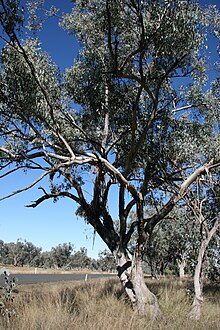Eucalyptus albens
| White box | |
|---|---|
 |
|
| Eucalytpus albens habit | |
| Scientific classification | |
| Kingdom: | Plantae |
| Clade: | Angiosperms |
| Clade: | Eudicots |
| Clade: | Rosids |
| Order: | Myrtales |
| Family: | Myrtaceae |
| Genus: | Eucalyptus |
| Species: | E. albens |
| Binomial name | |
|
Eucalyptus albens Benth. |
|
| Synonyms | |
|
Eucalyptus hemiphloia var. albens (Benth.) Maiden |
|
Eucalyptus hemiphloia var. albens (Benth.) Maiden
Eucalyptus albens known as the white box is a common eucalyptus tree of the western slopes and plains of New South Wales and adjacent areas in Queensland and Victoria. An isolated population grows in the southern Flinders Ranges in South Australia.
George Bentham described the white box in 1867 from material collected by botanist and explorer, Allan Cunningham, along the Macquarie River. Joseph Henry Maiden had regarded it as a subspecies of Eucalyptus hemiphloia in 1904. It is related to grey box (E. moluccana) and inland grey box (E. microcarpa). Hybridization with grey box has been reported in the Hunter Valley. The scientific and common names is derived from the white deposits over the leaves and gumnuts, while the epithet "box" comes from the box-like tesselated pattern in the bark.
Reaching 15–25 metres (49–82 ft) high, the white box has a branched spreading crown with a straight trunk for around half its total height. Its trunk may reach 0.5 metres (1 ft 8 in) diameter at breast height. It has fibrous pale grey bark. The juvenile leaves are round and pale. The white flowers appear in the autumn from March to May.
The white box is a tree of grassy eucalypt woodlands on plains or gently sloping areas.
It is associated with inland grey box, fuzzy box (E. conica), yellow box (E. melliodora), Pilliga grey box (E. pilligaensis), red ironbark (E. sideroxylon), narrow-leaved ironbark (E. crebra), Blakely's red gum (E. blakelyi), apple species (Angophora), black cypress (Callitris endlicheri), white cypress (Callitris glaucophylla), kurrajong (Brachychiton populneus) and wattles (Acacia) species.
...
Wikipedia
